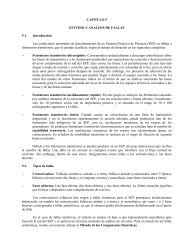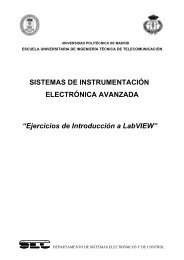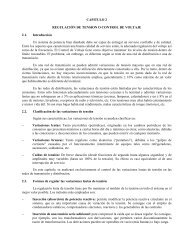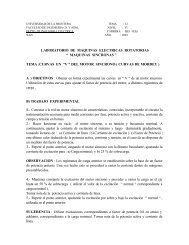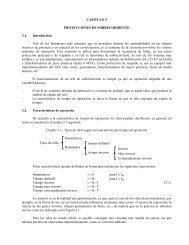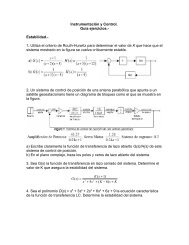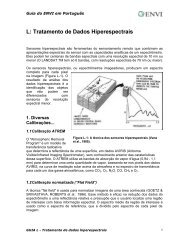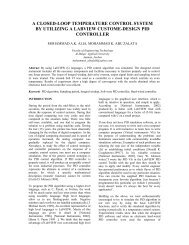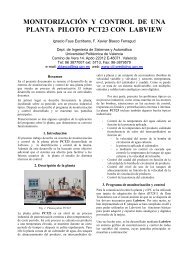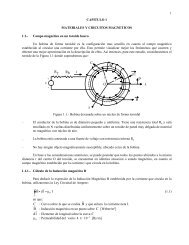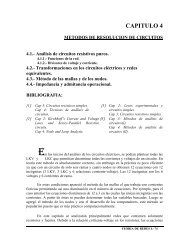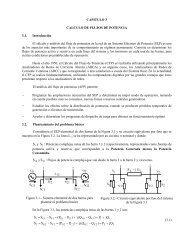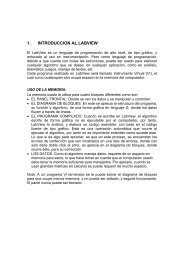T 7.2.1.3 Amplitude Modulation
T 7.2.1.3 Amplitude Modulation
T 7.2.1.3 Amplitude Modulation
Create successful ePaper yourself
Turn your PDF publications into a flip-book with our unique Google optimized e-Paper software.
TPS <strong>7.2.1.3</strong><br />
Solutions<br />
3 Review of amplitude modulation<br />
Answers<br />
3.1 <strong>Modulation</strong> means the frequency conversion<br />
of an information signal from the AF position<br />
of the baseband into the RF band of the<br />
carrier. Here, the modulating signal<br />
influences an appropriate parameter of the<br />
carrier oscillation, e.g. the amplitude or frequency.<br />
While f C >> f M always holds true in<br />
modulation, mixing entails frequency<br />
conversion being generated between signals<br />
with comparable frequencies.<br />
3.2 <strong>Modulation</strong> offers the following advantages:<br />
– Matching to the features of the transmission<br />
channel, i.e. improved efficiency<br />
during transmission of information signals.<br />
– Multiple utilization of transmission channels,<br />
e.g. in frequency multiplexing<br />
methods.<br />
– Improved signal-to-noise ratios (modulation<br />
gain)<br />
3.3 The DSB is something "new" produced by<br />
combining the carrier oscillation and the<br />
modulating signal. While the dynamic characteristic<br />
of the AM signal can be observed<br />
as a whole on the oscilloscope the spectrum<br />
analyzer shows the AM broken down into its<br />
components. With constant modulation<br />
signal these components have amplitudes<br />
contstant with respect to time.<br />
3.4 In the dynamic characteristic of the beat a<br />
phase shift of 180° arises in the envelope<br />
curve. The frequency of the envelope curve<br />
is approx. half the differential frequency of<br />
the oscillation components involved. The<br />
beat frequency corresponds to the arithmetic<br />
mean value.<br />
3.5 The amplitude deviation ∆A C indicates the<br />
maximum change permissible for the carrier<br />
amplitude A C . It is dependent on the<br />
modulator constant α and the amplitude A M<br />
of the modulating signal. The modulation<br />
index m is the quotient formed out of the<br />
amplitude deviation and the carrier amplitude.<br />
The modulation index m can assume<br />
values between 0 and 1. Overmodulation<br />
occurs for m > 1.<br />
3.6 In addition to envelope demodulation, synchronous<br />
or coherent demodulation are<br />
common demodulation methods particularly<br />
in commercial communications systems. In<br />
contrast to envelope demodulation, it requires<br />
an auxiliary carrier which is stable in<br />
terms of frequency, phase and amplitude.<br />
3.7 The reduction in carrier power means an<br />
improvement in the transmission efficiency.<br />
The amount of power and amplifier circuitry<br />
in the transmitter can be reduced.<br />
Bandwidth is saved by limiting modulation to<br />
one sideband. However, coherent demodulation<br />
becomes problematic when the carrier<br />
is completely suppressed. For that reason a<br />
residual carrier is transmitted with which the<br />
receiver is synchronized.<br />
3.8 The following applies for the efficiency η:<br />
useful power<br />
η =<br />
total power<br />
Expressed by the modulation index m the<br />
following holds true:<br />
η =<br />
m 2<br />
2+ m 2<br />
For the maximum modulation index<br />
m = 100% you obtain the best efficiency of<br />
the DSB when η = 33%! Regarding the<br />
power needed in DSB at least 2/3 is “squandered”<br />
in the carrier. Since the carrier contains<br />
no information it can be suppressed to<br />
increase the efficiency.<br />
3.9 Methods of carrier suppression<br />
– Suppress the carrier using a bandpass filter<br />
with very sharp cutoffs.<br />
– Addition of a carrier in phase opposition<br />
and of equal amplitude to the modulated<br />
signal.<br />
– Use of a modulation method which does<br />
not permit the carrier to reach the modulation<br />
product, e.g. balanced or ring<br />
modulator.<br />
3.10 Here only coherent demodulation still constitutes<br />
a viable alternative. For this an auxiliary<br />
oscillation is needed in the receiver,<br />
which is in agreement with the original carrier<br />
in terms of frequency and phase and<br />
whose amplitude remains constant.<br />
52



